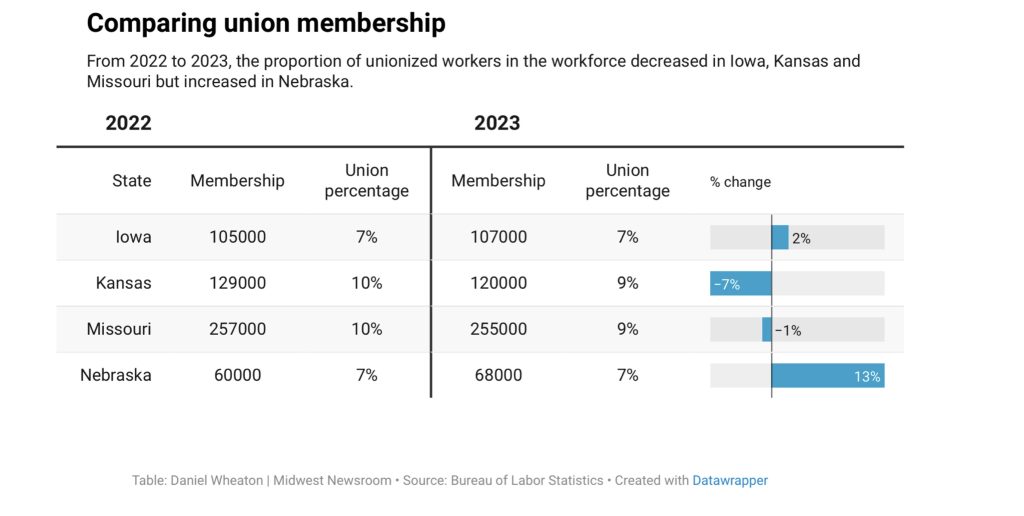According to the latest Bureau of Labor Statistics data, Iowa and Nebraska saw gains in union membership while Kansas and Missouri unions saw slight declines.
More people joined labor unions in Iowa and Nebraska in 2023, while Missouri and Kansas lost members, according to the latest figures from the Bureau of Labor Statistics (BLS), released Tuesday morning.
Nationwide, the number of wage and salary workers belonging to unions, at 14.4 million, inched up slightly over 2022, when the number was 14.3 million.
Michael Duff, a former Teamster who is now a law professor at St. Louis University, described the overall growth as essentially flat.
“The bottom line is, there’s been no movement,” Duff said. “I think it will be surprising for those who had expected an uptick in light of recent highly publicized labor actions.”

(Photo: Katie Long/
Katie Long Photography)
Among the actions that drew attention to unions in 2023 was the coordinated United Auto Workers strike in Missouri, Ohio and Michigan. Nurses in Kansas staged two strikes last year, and Starbucks baristas continued to make headlines for protests and other actions around the region.
“These actions don’t necessarily translate into overall organizing the workplace. That’s what the data seems to be showing me,” Duff said.
The BLS reported the national union membership rate — the percentage of wage and salary workers who are members of unions — was 10% in 2023, about the same as in 2022. By contrast, in 1983 (the first year for which comparable data are available), the union membership rate was 20% and there were 17.7 million union workers.
Jennifer Sherer, a director at the Economic Policy Institute, sees a silver lining in the data: People ages 16 to 45 are driving union membership growth and have decades of employment ahead of them.
“That’s not just polling and survey data, but that’s young people going through the very challenging and courageous process of organizing new unions even against the odds,” she said.
According to the BLS, 31 states and the District of Columbia had union membership rates below the U.S. average of 10% of the workforce in 2023. That group includes Iowa, Kansas, Missouri and Nebraska.

Nationwide, about 1 in 10 people are union members. That’s far from the glory days of organized labor in the 1950s, when 1 in 3 U.S. workers was in a union.
The BLS reported that across the country, the union membership rate of public-sector workers (32.5%) continued to be more than five times higher than the rate of private-sector workers (6%).
The highest unionization rates were among workers in education, training, and libraries (32.7%) and law enforcement (31.9%) — all public sector occupations.
Among the challenges to organized labor are right-to-work laws, which give states the authority to determine whether workers have to join a labor union to get or keep a job. Iowa, Kansas and Nebraska, are right-to-work states. Missouri voters rejected a right-to-work law in 2018.
Aside from the ways laws can undermine union clout, the assumption that workers could strike better deals for wages and benefits independently remains strong in the U.S. And, Duff said, the availability of credit reinforced a collective notion of financial security.
“By and large what happened was that people thought they didn’t need a union because they could get easy money,” Duff said.

(Photo: Economic Policy Institute/Provided)
Sherer, who is based in Iowa, said the fact that more than a quarter million private sector workers across the country joined unions in 2023 is cause for optimism in organized labor.
“Given the really substantial employer hostility and the weak labor laws that we have — all those obstacles that workers are up against, and yet we see 250,000 new members showing up in the data? I actually think that’s a pretty significant sign,” she said.
While the private sector may be attracting new union members, Sherer said public sector labor organizing is falling behind.
“One very clear trend is that interest and enthusiasm for unions — particularly among young workers — is at all-time historical highs” she said. “The public sector, however, is where we’re seeing the losses in union membership.”
She said Iowa and neighboring states have created “multiple roadblocks” to union organizing among public sector employees.
Uncertain times
As the Midwest Newsroom first reported in 2023, the rise in union membership — even at a slow rate — may be due to a sense of what economists call “precarity.”
“In the Great Recession we saw that everything could disappear,” said Sirisha Naidu, who teaches economics at the University of Missouri-Kansas City. “And in the pandemic, particularly if you were an essential worker, you were being asked to put your life on the line to keep your job. And yet you are not getting paid as much.”
Duff said insecurity about the economy and jobs has pushed baristas, restaurant workers and even pharmacy staff, to organize, protest and strike. Nurses, cereal company employees and auto workers across the Midwest are doing the same.
This uncertainty, or precarity, even at a time when unemployment is low.
“That sense of precarity is being pushed up the socioeconomic ladder right? So, all of a sudden, people who never thought they would be in an uncertain employment situation are in that situation,” Duff said.

(Photo: Luis Aispuro/Provided)
Frustrated by a revolving door of managers, scheduling and pay, baristas at Luis Aispuro’s store in Iowa City had been talking about unionizing since 2020. In 2023, he decided to move the process forward and connect with Starbucks Workers United, the central organizing body for workers.
After strikes in Iowa City and around the country on Red Cup Day (Nov. 16), Starbucks gave managers and supervisors the ability to turn off the mobile ordering system during busy periods to ease the strain on baristas.
A recent college graduate, Aispuro said there’s no downside to being a union member.
“Better working conditions. Better pay. Fewer hours,” Aispuro said. “The workers just get a bigger slice of the pie. You should get paid what you’re owed because wages have stagnated over the last 20, 30 years.”

Changing perceptions
The number of people in the U.S. who approve of labor unions has been climbing steadily since 2010, according to research from Gallup.
According to several workplace demography tracking websites, most Starbucks baristas are between the ages of 20 and 30. These workers have grown up and come of age in the shadow of the Great Recession, global warming and the pandemic, Naidu said, so it’s no surprise they would seek job protections through unionization.
“They have not seen anything different, right? They have entered this world seeing a society that seems pretty devastated. And you can’t convince them that there is something better,” she said.
People born in the mid-1990s and later differ from their elders in their perception of organized labor, too, Naidu said. Gone is the outdated perception of union members as disgruntled workers who are looking to stir things up.
“Union is not such a dirty word in our region right now,” Naidu said.
Still, Duff said, union activity is far from robust.
“In 2022 there were 23 major work stoppages (of 1,000 or more workers),” he said. “That sounds like a lot, right? The year that I graduated from high school, 1977, there were 300.”
Duff said that while jobs in the so-called “gig economy” continue to add to U.S. employment figures, they are eroding the potential influence of organized labor. The law considers workers for rideshare and food delivery companies as private contractors, who are not eligible to unionize.
“As that gig economy gets bigger and bigger, the opportunities for union membership reduce and reduce and reduce,” Duff said. “If you’re not an employee as defined by law, you have no labor rights.”
Cover Photo: A passing car waves American flags in support of striking United Auto Workers on Sunday, Sept. 24, 2023, at the General Motors Assembly Plant in Wentzville, Mo. (Credit: Brian Munoz, STLPR)
Publisher’s Notes: This story comes from the Midwest Newsroom, an investigative journalism collaboration including IPR, KCUR 89.3, Nebraska Public Media News, St. Louis Public Radio and NPR.
What to know about new labor union membership numbers in the Midwest was originally published in KCUR, and was republished with permission.
